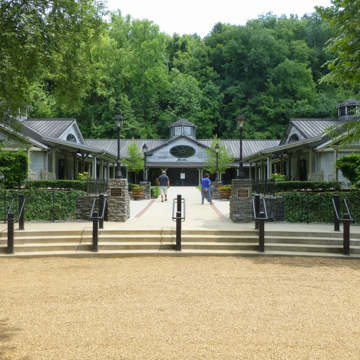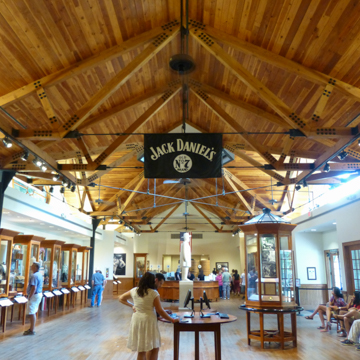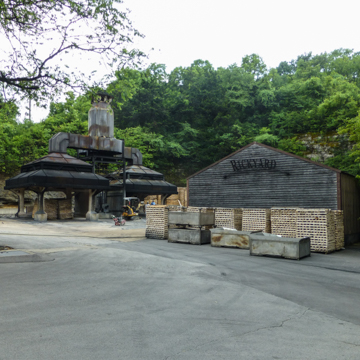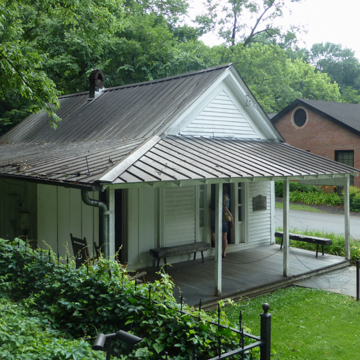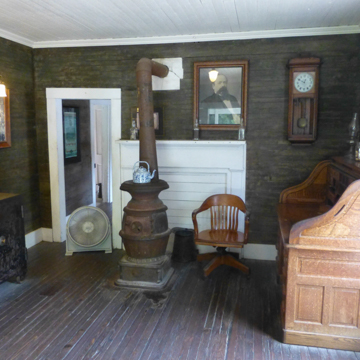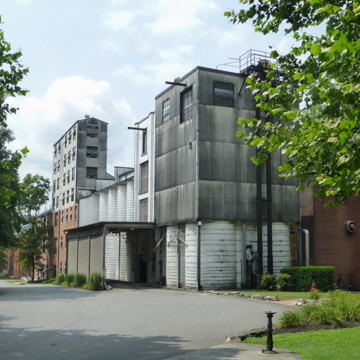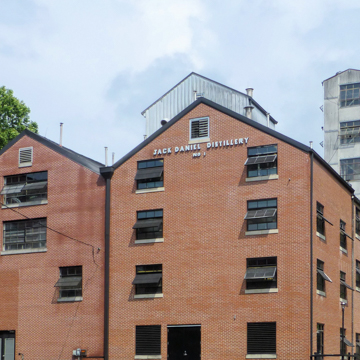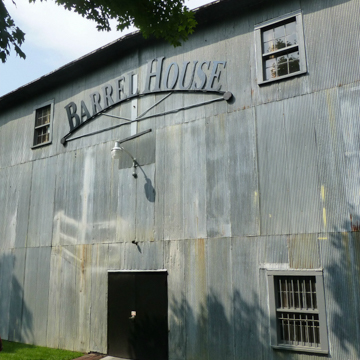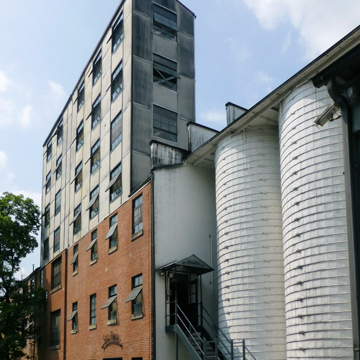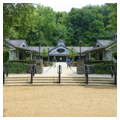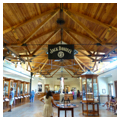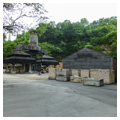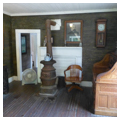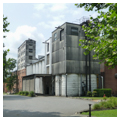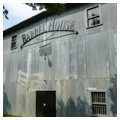You are here
Jack Daniel’s Distillery
Jack Daniel’s is the oldest distillery in the state, founded in 1875 at the site of a limestone cave spring in rural Moore County. It is also the largest and most famous maker and distributor of “Tennessee Whiskey,” a liquor made much like bourbon, and from the same ingredients, but distinguished by its filtering through vats of ground charcoal prior to barrel aging.
Jack Daniel (c.1849–1911), one of thirteen children, lost his mother near the time of his birth. After his father died during the Civil War, the teenager was raised by Reverend Dan Call, a Lutheran preacher and moonshine distiller. Daniel and Call marketed their product as early as 1866 and registered a legal distillery in 1875, with Call leaving the business to Daniel soon after. In 1884 Daniel purchased the spring and the surrounding land; the distillery he built there was one of 15 in Moore County at the time. The source of the spring is a deep cave located beneath of limestone cliff in the Elk River watershed. The limestone naturally filters iron from the 56-degree water, making it ideal for whiskey.
While anecdotes abound about Jack Daniel himself—how he became a moonshine maker as a teenager, how he died after breaking a toe kicking his office safe, etc.—information about the buildings on his distillery is lacking. Even when the property was evaluated in the early 1970s for inclusion on the National Register, nothing was recorded about the architectural chronology of the campus.
Stylistic analysis and oral tradition indicate that the oldest building on the grounds is Jack Daniel’s office, a small, wood-framed, saltbox cottage (c. 1885) located directly in front of the cave spring. A rock dam, surmounted by a 1941 statue of the founder, diverts the spring from the cottage office. Within the building are old photographs and artifacts associated with the founder. Near the office is the “Rickyard,” where ricks of stacked sugar maple are burned beneath two massive metal hoods to make the filtering charcoal.
Most of the 80 or so buildings on the grounds are warehouses filled with nearly two million barrels of aging whiskey. The oldest warehouse is also the smallest; “Barrel House #1” (c. 1930) is located near the stream and next to the present-day visitor’s center. Later barrel houses erected at the distillery reach eight stories. All are topped with metal gable roofs and sheathed in corrugated galvanized sheet metal. Most were built after 1946, when the distillery returned to producing whiskey after World War II. Most warehouse buildings are located atop the hills, overlooking the hollow and the town of Lynchburg, and they are sufficiently spaced on the grounds to prevent the spread of fire, a necessary precaution given the flammable contents.
Rebuilt after 1946 is “The Still House,” the main distillery building. About half of this complex structure holds silos for the corn, barley, and rye waiting to be cleansed, ground, mixed and fermented. The other half of the building contains the mash tubs, fermenters, charcoal mellowing vats, and barreling rooms. The tallest part of the building encloses the spiraling coils of the still.
Other buildings nearby include administrative and delivery buildings, most of them sheathed in brick, set on fieldstone foundations, and pierced with large industrial metal windows, as seen in the building labeled “Jack Daniel Distillery No 1.” (c. 1956). None of these buildings is open to the public.
The main public space at the distillery is the Visitor Center, which opened in 2000. It was designed by HOKe, an offshoot of the largest architecture firm in the United States (Hellmuth, Obata and Kassabaum) that was founded in 1995 to specialize in themed environments for entertainment and related venues. Set within the hollow that embraces most of the distillery’s buildings, and next to the stream, the Visitor Center contains a theater, retail space, and displays on barrel-making, whiskey filtering, and other aspects of Jack Daniel’s production. Designed with a Postmodern approach reminiscent of Tennessee’s rural and vernacular building traditions, the Visitor Center is covered with a truss roof sheathed on the inside with planks that also evoke the slats used to make barrels. Each segment of the U-shaped building is topped with a gable and short octagonal tower. Stone walls and trees surround the structure and integrate it with the rest of the wooded campus.
Jack Daniel had no wife or children, but he taught two of his nephews the business and in 1907, with his health failing, he gave them the business to run. Lemuel Motlow bought out his cousin’s share and became the distillery’s sole proprietor from 1911, the year of Jack’s death, until Motlow’s own passing in 1947. (Motlow’s two-story Greek Revival house, circa 1850, still stands next to the distillery.) It was Motlow who steered the company through state and federal prohibition and through the government’s ban on whiskey production during World War II. His children inherited the company and then sold it to the Brown-Forman Corporation in 1956. Since then, Brown-Forman has continued to market the Tennessee whiskey in Daniel’s distinctive square bottles, first used in 1897 and adorned with the black “Old No. 7” label. Jack Daniel’s is the leading U.S. whiskey producer and the distillery is the largest employer in Moore County and the source of much of the area’s wealth.
References
Eberline, May Dean, “Jack Daniel Distillery,” Moore County, Tennessee. National Register of Historic Places Inventory–Nomination Form, 1972. National Park Service, U.S. Department of the Interior, Washington, D.C.
“HOK launches Studio E; designers and producers to the global entertainment industry.” The Free Library. Accessed April 5, 2018. http://www.thefreelibrary.com/.
Krass, Peter. Blood and whiskey: the life and times of Jack Daniel. https://en.wikipedia.org/wiki/Hoboken,_New_JerseyHoboken, NJ: Wiley, 2004.
Writing Credits
If SAH Archipedia has been useful to you, please consider supporting it.
SAH Archipedia tells the story of the United States through its buildings, landscapes, and cities. This freely available resource empowers the public with authoritative knowledge that deepens their understanding and appreciation of the built environment. But the Society of Architectural Historians, which created SAH Archipedia with University of Virginia Press, needs your support to maintain the high-caliber research, writing, photography, cartography, editing, design, and programming that make SAH Archipedia a trusted online resource available to all who value the history of place, heritage tourism, and learning.














